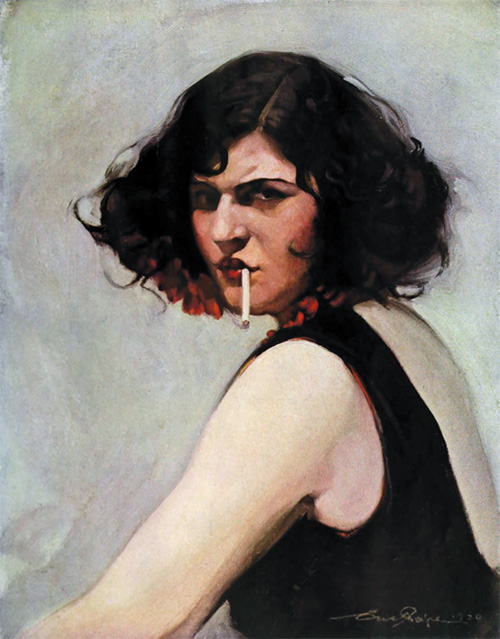From the Publisher – May 2024
Reverie and Contemplation
“Don’t go to a museum with a destination.
Museums are wormholes to other worlds.
They are ecstasy machines. Follow your eyes
to wherever they lead you…and the world
should begin to change for you.”
— Jerry Saltz, art critic
Please meet The Cobra by American artist Eric Pape (1870–1938). Finding her was the result of attending the Gertrude Cawein at Hammond Castle Museum exhibition opening this past April. (Pape lived in the Castle as a close associate of John Hays Hammond Jr. for a time.) Now, I did not meet The Cobra in person; the painting is actually lost in this moment. Yet I entered the wormhole that night, marveling at Pape’s work; chatting with Dr. Gregory Conn, one of the world’s leading Pape experts and biographers whose collection was on display; and learning more about the extraordinary yet somewhat overlooked backstory of Hammond and the Museum itself, as well as the equally compelling story of its current renaissance. (See Museums of the Moment, beginning on page 40). Museums are “wormholes to other worlds.”
Perusing Pape’s website led to discovering this painting which Conn believes to be “the young actress Carmen Cortes (1915–1991) who had an illustrious career in Spanish language film in Mexico… The facial similarity is striking. I only have a single reference to her name in a legal document.” Her smoldering gaze and indifferent shoulder suggest a guarded exterior. Who has called to her? What is she thinking? What can she not be bothered with? I want to know and if this painting were in a museum today, I’d be sitting in front of it, seeing where this dialogue leads. As Saltz suggests.
I can’t tell you how exciting it is to work on an issue that celebrates these incredible spaces. I almost wrote “institutions” and while the term speaks to the historical significance of museums as venerable repositories of important work, the word is, well, too institutional. Museums are not prisons where precious art is incarcerated. They are the opposite. There are walls, yes, yet there are no walls around our imaginations or emotions as we spend hours wandering and wondering.
“They are ecstasy machines,” says Saltz. That high on art feeling is what draws many of us in. It’s the safest and yet most boundless of experiences. I walked New York’s Armory Show—a museum of sorts—with John Stomberg, director of the Hood Museum at Dartmouth, several years ago. With “kid in a candy store” glee, he’d glide from piece to piece with intel and anecdotes and we, his posse that day, were ecstatic to be in his presence as much as we were the art. I recently walked the new Bruce Museum with Taylor Gray, the museum’s marketing consultant, and was impressed by his intimate knowledge of the work as he shared which pieces resonate the most for him. When I toured Hammond Castle Museum earlier this year I was struck by the enthusiasm of the Castle’s director of visitor services and education Caleb McMurphy, whose knowledge of all things Hammond and his artifacts would fill volumes. One wonders if the spirits of the Castle’s famous guests and residents somehow possess McMurphy. He speaks fast and precisely, no detail left unspoken. Yes, the ecstasy is real.
“…the world should begin to change for you.” Let it. Let art in. Perhaps you’ll be inspired to become a member at your favorite museum. Even if museums are not your vibe, I hope this issue changes that as you read about new exhibitions in old, familiar spaces; brave new concepts in museum-going; and small museums you may be overlooking.
In this issue, Susan Saccoccia shares her profound experience at Steve McQueen’s Lynching Tree which was at the Isabella Stewart Gardner Museum; Chris Volpe updates us on how arts can change an entire city as we revisit the community work happening at Fitchburg Art Museum; Jennifer Mancuso introduces us to Kayla G. Coleman, the new director of the New England Museum Association; Jack Curtis writes on the elevation of the Yiddish Book Center into a museum; Abbi Kenny shares her Studio Visit with the brilliant young artist Wiley Holton; and Carl Little spotlights Paula Tognarelli’s Collection at the Maine Museum of Photographic Arts. And there is so much more. We take you to the Berkshires and across New England in the Destination sections and spark early summer gallery hopping in Exhibitions.
I want to close this letter and start this
issue with a piece by Stomberg on the paradox within the museum experience today. How does a museum remain a place of reverie and contemplation while also reflecting the critical social issues of our time? Enter the wormhole to learn more.
In gratitude,
Rita A. Fucillo
Publisher

ON THE COVER: Eric Pape, The Cobra,
1930, oil on canvas, 52 x 66.5 cm.
Courtesy of Greg Conn. See page 40.
